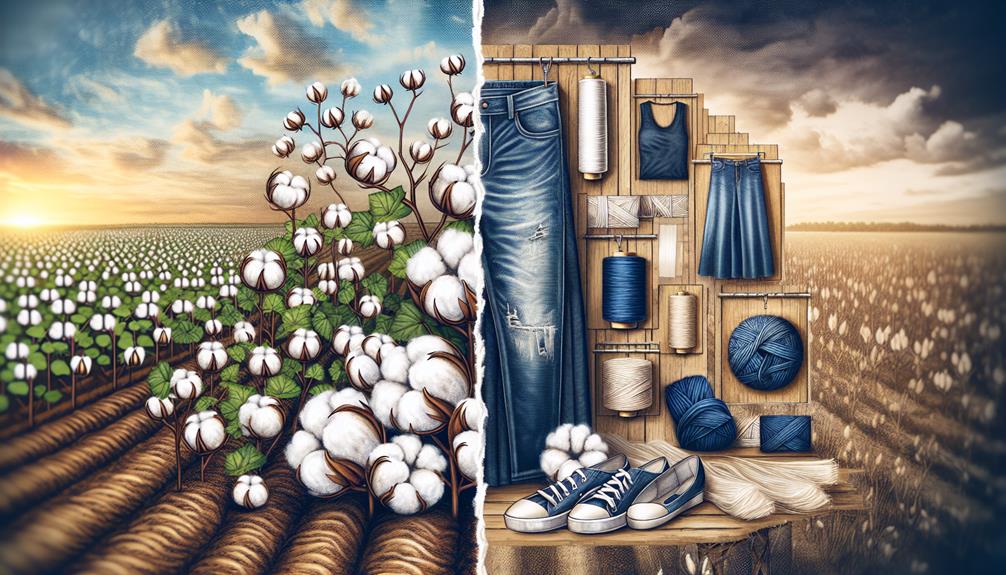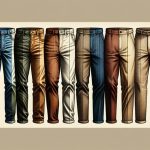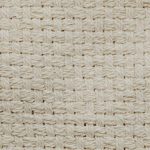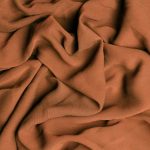So, I've been thinking a lot about denim lately, and it's kinda sparked this question in my mind: Is denim actually a fabric, or should we be calling it a material? I mean, we all know it's made from cotton, which is definitely a material, right? But then, it's woven into this durable twill that we wear pretty much everywhere, from jeans to jackets, making it seem more like a fabric. It's a bit of a head-scratcher, and I'm curious to explore more about its origins, how it's made, and why it's so central to our wardrobes. Maybe together, we can unravel this mystery.
Table of Contents
Key Takeaways
- Denim is a type of fabric made from cotton.
- It is characterized by its sturdy cotton twill weave.
- Denim is used as a material to create various clothing items.
- The term "material" can refer to denim in the context of its application in fashion.
- Fabric refers to the textile itself, making denim a specific kind of fabric.
Understanding Denim
At its core, denim's a tough fabric made from cotton that's become a staple in everyone's wardrobe. You know, it's that go-to material for jeans, jackets, and even those cute summer dresses we all love. Now, let's dive a bit deeper into this world of cotton denim. It's all about that sturdy cotton twill woven together, and let's not forget, it comes in shades like indigo, gray, or even mottled white.
What's really cool about denim is its versatility. We're talking about several types of denim fabric here. There's the classic, the one that molds to your body the more you wear it, making those jeans feel like a second skin. Then, there's the raw denim, that untouched, crisp version that fades uniquely to you. And don't get me started on the distressed kind, which gives you that lived-in look right off the bat.
Understanding denim means recognizing its roots in durability and moldability, thanks to being made from 100% cotton. This fabric isn't just about fashion; it's about creating pieces that last, get better with age, and essentially, tell your story.
The History of Denim
Tracing back to Nimes, France, denim's story starts long before it became the fashion staple we know today. It's fascinating to dive into the history of denim, especially considering its humble beginnings. Originally, this durable and strong fabric was all about practicality, serving as the go-to material for workwear. You could say it was the unsung hero for the hardworking folks back in the day.
Then enters Levi Strauss in the 1870s, a name practically synonymous with denim. His role in popularizing denim, particularly in making those iconic jeans, is a pivotal chapter in the fabric's history. It's wild to think how a simple material used for durability turned into a fashion statement.
How Denim Is Made
After exploring denim's rich history, let's get into how it's actually made. The journey from cotton to the denim we all love is fascinating and involves several steps, each crucial to giving denim its unique characteristics.
| Step | Description |
|---|---|
| 1. Cotton Selection | Only the best cotton is chosen to make denim. |
| 2. Dyeing | The cotton yarn is dyed, usually with indigo dye to get that classic blue color. |
| 3. Weaving | This is where the magic happens. The dyed cotton yarn is woven together in a twill pattern. |
| 4. Finishing | Processes like sanforizing are applied to stabilize the fabric and minimize shrinkage. |
| 5. Inspection | Every inch of denim is checked to ensure top quality. |
The whole process starts with selecting the right cotton. It's all about the feel and durability. Then, indigo dye comes into play. It's what gives denim its identity. Weaving this dyed yarn creates denim's iconic diagonal ribbing. But it's not just about weaving; finishing touches are crucial too. They make sure the denim won't shrink too much after you buy it. Let's dive in deeper and understand each process, shall we?
Types of Denim Fabric
Let's dive into the different types of denim fabric, each with its unique characteristics and appeal. When you're talking denim, understanding the types is key to mastering your denim game.
First up, raw denim. This type is all about keeping it real—untreated, unwashed. It's the canvas of your life, changing and fading where you fold, sit, and live, giving you a pair that's uniquely yours.
Then there's selvedge denim, the old-school, high-quality stuff with a self-finished edge that screams durability and sports a vintage vibe.
Don't forget stretch denim. If you've ever wished your jeans could hug you back, stretch denim's your friend. A little elastane goes a long way in making jeans that move with you, perfect for those form-fitting looks.
Acid wash denim brings that 80s nostalgia, with its distinctive faded, almost snowy appearance that's all about standing out. And for the lovers of that well-loved, been-through-life look, distressed denim has the aged, worn vibe down, creating an edgy aesthetic without the wait.
Each type offers something special, making the world of denim rich and varied. It's all about finding the right fit for your style and your story.
Denim in Fashion
Exploring the types of denim fabric prepares us to understand how denim has become a fashion icon over the years. Ever since Levi Strauss brought denim jeans into the limelight in the 1870s, they've transcended their workwear origins to become a staple in everyone's wardrobe. What's fascinating is how denim has evolved – from the rugged raw denim worn by miners to the diverse styles we see today.
- Raw denim stands out for its durability and unique way of molding to one's body, creating a personalized fit over time.
- Stretch denim has brought comfort to the forefront, making jeans more accessible and enjoyable for everyday wear.
- Selvedge denim offers a premium quality with a clean edge that appeals to denim connoisseurs.
- Acid wash and distressed denim introduce texture and an edgy aesthetic, catering to those looking to make a fashion statement.
- Denim skirts and jackets extend the fabric's versatility beyond jeans, proving its ability to adapt to various fashion trends.
Denim's cultural significance and timeless appeal have solidified its place in fashion, proving it's more than just material; it's a canvas for personal expression. Whether it's the classic appeal of raw denim or the modern twists of distressed looks, there's no denying denim's enduring role in fashion.
Caring for Denim
So, here's the deal on keeping our denim looking and feeling its best.
I've found that turning jeans inside out before throwing them in the wash really does keep the color from fading.
And, I only wash mine every few wears to make sure they don't lose that perfect fit and feel.
Washing Denim Properly
Caring for your denim the right way can make it last longer and keep it looking its best. When it comes to denim fabrics, understanding the proper washing techniques is crucial. Here's what I've learned:
- Wash denim inside out to prevent fading and keep the color looking vibrant.
- Only wash denim every five wears to maintain its quality and shape.
- Tumble dry on a low setting to retain the fit and avoid excessive shrinkage.
- Following the recommended care instructions can seriously extend the lifespan of your denim.
- Proper washing and drying not only help denim age gracefully but also become softer with wear.
Mastering these basics has really upped my denim game!
Preventing Denim Fade
To keep your denim from losing its color, there are a few simple tricks you can try.
First off, washing your denim inside out is a game-changer. It reduces the friction and shields the indigo dye from harsh detergents and direct contact with water, which helps big time in preserving the color.
Also, sticking to cold water during washes keeps the color intensity of your denim fabric on point. Instead of tossing them in the dryer, air-drying your denim pieces prevents the color from fading due to excessive heat.
And here's a pro tip: adding a cup of white vinegar to the rinse cycle can really set the dye and cut down on fading. Trust me, your denim will thank you!
Denim and the Environment
So, let's talk about how denim plays into environmental issues.
I've learned that making jeans can really hurt the planet, but there are cool ways to make it better, like using less water and recycling old pairs.
And now, brands are getting smarter about being green and kinder to the earth, which is pretty awesome.
Denim Production Impact
Denim's production packs a punch on our planet, using tons of water, harmful dyes, and energy. It's not just about the cool jeans we love; it's about how they're made and the impact they've got on the environment. Here's the deal:
- The industry's gobbling up massive amounts of water for just one pair of jeans.
- Those vibrant blues? They come from chemical dyes that are tough on our planet.
- Energy consumption's through the roof with all the manufacturing processes.
- Fast fashion's pushing for more and more denim, upping the environmental stakes.
- But there's hope with brands turning to eco-friendly practices, trying to do denim right.
I'm all for supporting those who're making the effort to switch up their game with sustainable practices. It's about making better choices for our planet, one pair of jeans at a time.
Recycling Denim Challenges
Recycling denim's tougher than you might think, especially with all those zippers and buttons getting in the way. It's not just about tearing old jeans apart.
The real kicker? That indigo dye. Getting rid of it without messing up the environment is a puzzle.
And let's not forget, to turn those worn-out jeans into something useful like insulation, you need some pretty hefty machinery. With folks getting keener on eco-friendly options, the pressure's on to find better ways to recycle denim.
Now, there's chatter about chemical recycling – sounds fancy, right? It's supposed to make dealing with that stubborn dye and turning denim into new fibers easier. But it's early days, and I'm keeping my eyes peeled for how it pans out.
Sustainable Denim Solutions
In tackling the issue of denim waste, programs like Cotton's Blue Jeans Go Green® are stepping up to transform old jeans into something new and eco-friendly. They're making a big impact by turning our tossed-out threads into housing insulation. It's all about giving those cotton fibers a second life.
Here's why recycling denim matters:
- Keeps tons of waste out of landfills.
- Saves valuable resources by repurposing cotton fibers.
- Supports community initiatives by donating to those in need.
- Encourages a culture of sustainability and environmental responsibility.
- Highlights the importance of eco-friendly practices in the fashion industry.
Denim Fabric Certifications
I'm checking out how denim gets its creds, and it turns out there are a bunch of certifications that matter. First off, Supima certification is a big deal because it means the denim fabric made from U.S.-grown organic cotton is top-notch. It's like a quality stamp for your jeans, ensuring they're made from the good stuff.
Then there's the Cradle to Cradle certification, which shows denim manufacturers are all in when it comes to sustainable practices. It's not just about the end product; it's the whole journey from design to production that's eco-friendly.
GOTS certification is another key player. It's all about verifying that the organic fibers used in denim fabric really are organic. This one's especially for those of us who wanna make sure our fashion choices aren't hurting the planet.
OEKO-TEX Standard 100 is about safety. It guarantees that denim products won't have any harmful substances. Pretty comforting, right?
Lastly, BCI certification focuses on promoting ethical and eco-friendly cotton production. Denim manufacturers who rock this cert are basically saying they care about the planet and the people on it.
All these certs? They're how you know your denim's legit, both in quality and ethics.
Denim's Global Production
As we dive into the world of denim's global production, it's clear that countries like India, the United States, and China are leading the charge. The shift towards overseas manufacturing in the late 20th century has really shaken things up, making these countries major players in the denim scene.
Here's a quick rundown of what's happening on the global stage:
- India is known for producing some top-notch quality denim. They've got a reputation for this stuff.
- China isn't lagging behind either. They're a significant contributor to the denim market, helping it grow even more.
- The United States has a rich history with denim, especially with the traditional Levi 501 jeans that are still a hit worldwide.
- The global interest in denim isn't fading anytime soon, with these countries pushing the boundaries.
- The shift to overseas manufacturing has allowed for a more diverse production landscape, making denim more accessible and innovative.
It's fascinating to see how denim's global production plays out, with each country bringing something unique to the table. This worldwide network ensures that our love for denim stays strong, fueling new trends and designs.
The Cost of Denim
After exploring how different countries are shaping the global denim production, let's talk about what hits our wallets: the cost of denim. You know, the price tag on that pair of jeans isn't just random. It's all about what you're getting and who's making it.
So, here's the lowdown. The cost of denim can swing wildly. If you're looking at premium brands, you're paying for top-notch materials and some serious craftsmanship. These aren't your run-of-the-mill jeans; we're talking about pieces that feel like a second skin and last forever. But, of course, that comes with a higher price.
Then, there's designer denim. This stuff? It's in another league. We're talking prices that can make your wallet weep, but it's all about exclusivity and style. If you're into fashion, you get why these jeans cost a pretty penny.
Don't forget vintage or limited editions. These can fetch some serious cash, especially if they're rare. It's not just about the denim; it's the story, the rarity, and yeah, the brand's reputation plays a big part too.
Denim's Material Composition
So, I've been thinking about what really makes denim, denim.
It's not just about the cotton twill or the indigo dye; it's how these materials are woven together and then dyed that's fascinating.
Let's talk about the core fibers, the process of weaving denim, and how it's dyed to get that classic look we all love.
Denim's Core Fibers
Let's dive into what makes denim so special: its core fibers, primarily cotton, make it both durable and comfy. When you're picking out your next pair of jeans or jacket, keep in mind that not all denim is created equal. Here's why:
- Cotton fibers provide the backbone, offering both toughness and a soft feel.
- A touch of synthetic fibers, like elastane, adds that much-loved stretch.
- This blend ensures your denim isn't just breathable but also molds to your shape over time.
- Low maintenance? You bet. Cotton makes caring for denim a breeze.
- Understanding this mix helps tailor your choice to your exact needs and preferences, especially if you're eyeing stretch denim for that perfect fit.
Weaving Denim Fabric
Now that we've covered the core fibers that make denim comfortable and durable, we'll explore how denim fabric is woven and why its material composition matters. The magic happens with the twill weave, where cotton yarn is interlaced in a way that gives denim its iconic strength and look. This process isn't just about tangling threads; it's a deliberate dance between warp and weft yarns, creating a fabric that's ready for anything.
| Aspect | Detail | Impact |
|---|---|---|
| Weave Pattern | Twill | Durability & Texture |
| Yarn Type | Cotton | Comfort & Breathability |
| Yarn Color | Indigo/Gray/White | Characteristic Appearance |
Understanding the weave and material of denim highlights why it's such a reliable fabric. It's all about the right combination of cotton yarns and weaving techniques.
Dyeing Process Explained
Diving into the world of denim, it's crucial to understand how its unique colors come to life through the dyeing process. The heart of denim's hue lies in its material composition and the methods used to dye the cotton yarn. Here's a quick rundown:
- Cotton yarns are saturated with indigo or sulfur dyes to get their color.
- Indigo dye is the go-to for that classic blue denim.
- Rope dyeing techniques are employed to achieve traditional blue hues.
- For those special, out-of-the-box colors, sulfur dyeing steps up to the plate.
- The choice of dye and dyeing process is key to denim's distinctive look and feel.
Grasping these basics is a giant leap towards mastering denim's complex world.
Frequently Asked Questions
What Qualifies as Denim?
To me, denim's qualified by its sturdy cotton twill, woven with indigo or similar yarns. It's gotta be durable, mold to your body, and easy to care for, like in jeans and jackets.
Is Denim Made of 100% Cotton?
I've learned that true denim is indeed made of 100% cotton. This gives it the toughness and ability to shape to one's body over time. Plus, it's low maintenance and holds a classic look.
Is Denim a Tough Fabric?
Yes, denim's definitely a tough fabric. It's made from cotton twill, making it super durable and resistant to wear and tear. Plus, it gets even better with age, molding to your body perfectly.
Is Denim a Heavy Fabric?
I'd say denim can definitely be heavy, especially when it's in the 11oz to 20oz range per square yard. That's what makes it so durable and perfect for tough workwear like jeans and jackets.
- Jaclyn Smith Fabric Coconut: a Review of This Rayon/Polyester Blend - June 29, 2025
- Jaclyn Smith Fabric Coconut: a Review of This Rayon/Polyester Blend - June 29, 2025
- How to Get Coconut Oil off Fabric Without Washing - June 29, 2025







